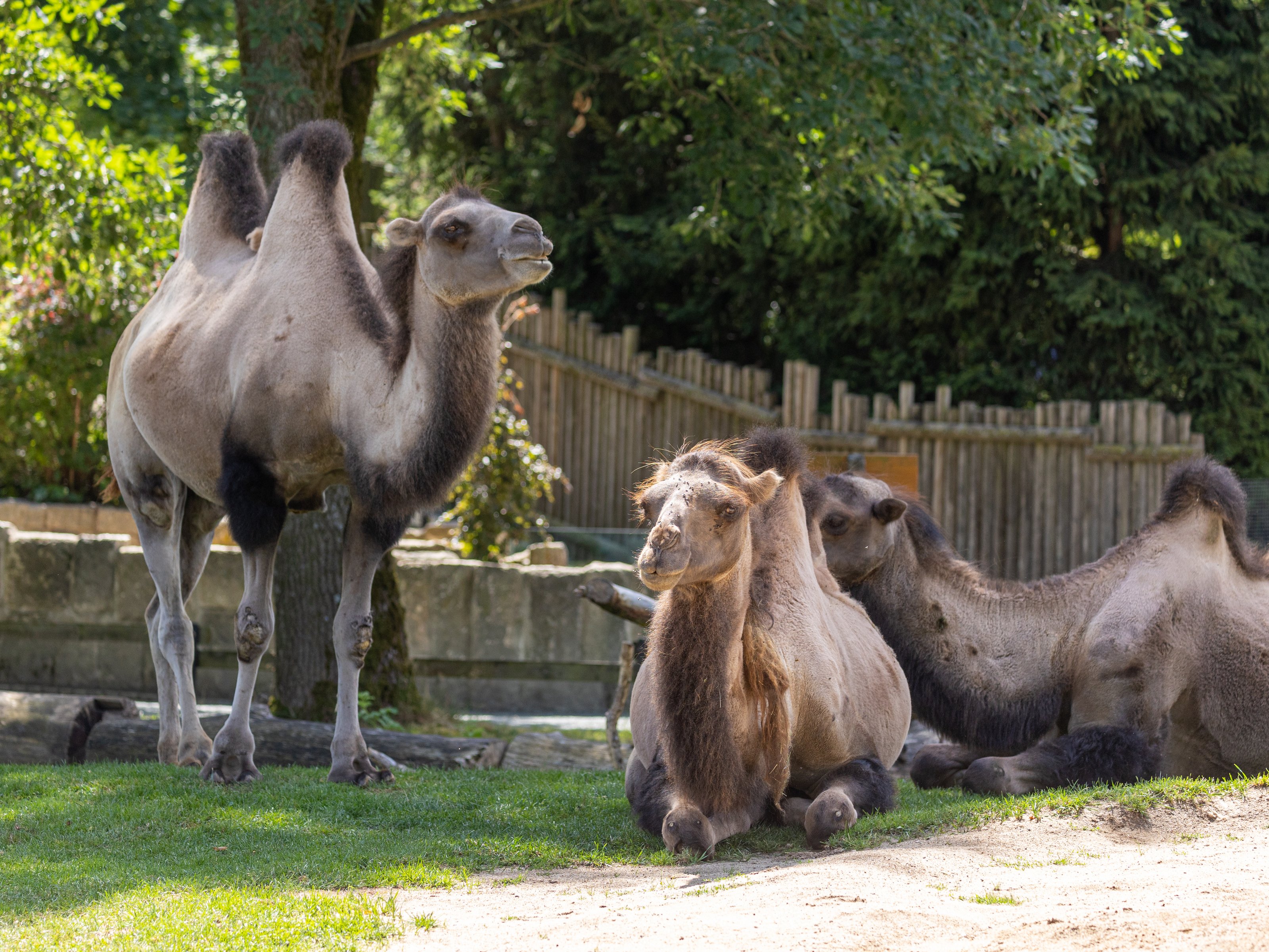
Station 19 Trampeltier
Nun, leider ist es vorbei mit dem schönen Märchen, dass Kamele in ihren Höckern Wasserreserven durch die Wüste tragen. Trotzdem können diese wunderbar an das Wüstenleben angepassten Tiere Trockenperioden unbeschadet überstehen. In den Höckern sind Fettspeicher angelegt und dienen lediglich als Energiereserve, mit dem Nebeneffekt, dass diese Fettpolster wunderbar vor Hitze und Kälte schützen. Bei extremen Wassermangel, wird nicht wie bei anderen Säugetieren, dem Blut, sondern in erster Linie der Muskulatur und verschiedenen Organen Flüssigkeit entzogen. Eingelagert werden kann dagegen Flüssigkeit in den drei Vormägen. Sehr konzentrierter Urin und trockener Kot hilft ebenso gegen Flüssigkeitsverlust. Kamele haben die Besonderheit, nach überstandener
Durstperiode sehr schnell ihr Flüssigkeitsdefizit auszugleichen, was hingegen für den Menschen zum Beispiel tödlich wäre. So kann ein Kamel innerhalb von zehn Minuten
135 Liter Wasser zu sich nehmen.
Haben Sie sich schon mal die langen Wimpern und die verschließbaren Nüstern angeschaut? Da kann ein Sandsturm kaum Schaden anrichten.
Trampeltiere können Temperaturdifferenzen bis zu 80°C ertragen. Dazu legen sie sich dicht nebeneinander um Kälte in der Nacht und Hitze am Tage besser trotzen zu können.
Übrigens bezeichnet man die zu den Kamelen gehörenden Lamas und Alpakas als Neuweltkamele und das Trampeltier und Dromedar zu den Altweltkamelen.
Der Tiergarten ist froh, dass unsere Tiere den kleinen Absperrgraben akzeptieren und ihr Gehege nicht verlassen. Warum sie das tun, können wir nicht schlüssig beantworten.
Station 19 Velbloud dvouhrbý
Pohádka o tom, že velbloudi nosí přes poušť zásoby vody ve svých hrbech, bohužel skončila. Tato zvířata, která jsou skvěle přizpůsobena životu v poušti, však mohou bez úhony přežít období sucha. V hrbolech se totiž nehromadí voda, ale tukové zásoby, které slouží pouze jako energetická rezerva a jejich vedlejším efektem je, že poskytují skvělou ochranu proti horku a chladu. V případě extrémního nedostatku vody se tekutiny neodčerpávají z krve jako u jiných savců, ale především ze svalů a různých orgánů. Na druhou stranu může být tekutina uložena ve třech výstelkách žaludku. Proti ztrátě tekutin pomáhá také velmi koncentrovaná moč a suchá stolice. Velbloudi mají tu zvláštnost, že po období žízně
jsou velbloudi schopni nedostatek tekutin velmi rychle vyrovnat, což by například pro člověka bylo smrtelné. Velbloud dokáže během deseti minut
vypít 135 litrů vody.
Podívali jste se někdy na dlouhé řasy a uzavíratelné nosní dírky? Písečná bouře tam sotva může napáchat nějaké škody.
Velbloudi dvouhrbí snášejí teplotní rozdíly až 80 °C. Proto leží blízko u sebe, aby lépe odolávali chladu v noci a teplu ve dne.
Mimochodem, lamy a alpaky, které také patří mezi velbloudy, se nazývají též velbloudi Nového světa a velbloud dvouhrbý a dromedár patří mezi velbloudy Starého světa.
Naše zoologická zahrada je ráda, že naše zvířata akceptují malý ochranný příkop a neopouštějí svůj výběh. Proč to dělají, nemůžeme jednoznačně odpovědět.
Station 19 Bactrian Camel
Well, unfortunately, it is over with the beautiful fairy tale that camels carry water reserves in their humps through the desert. Nevertheless, these animals, wonderfully adapted to desert life, can survive dry periods unscathed. Fat stores are created in the humps and serve only as an energy reserve, with the side effect that these fat pads protect wonderfully from heat and cold. In the case of extreme water shortage, fluid is withdrawn not from the blood, as in other mammals, but primarily from the muscles and various organs. On the other hand, liquid can be accumulated in the three forestomachs. Very concentrated urine and dry faeces also help against fluid loss. Camels have the peculiarity to compensate their liquid deficit very quickly after overcoming thirst, which, on the other hand, would be fatal for humans, for example.
Thus, a camel can consume 135 litres of water within ten minutes.
Have you ever looked at the long eyelashes and the closable nostrils? A sandstorm can hardly do any damage there.
Bactrian camels can tolerate temperature differences of up to 80°C. To do this, they lay close together to better withstand cold at night and heat during the day.
By the way, the llamas and alpacas belonging to the camels are called New World camels and the Bactrian camel and dromedary belong to the Old-World camels.
The zoo is happy that our animals accept the small barrier trench and do not leave their enclosure. We cannot conclusively answer why they do this.